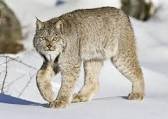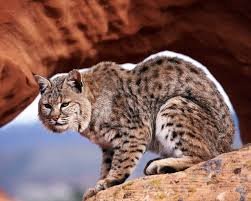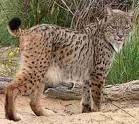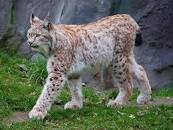Lynx.

Lynx (lat. Lynx is a genus of predatory mammals of the cat family, which is divided into several types:
- Eurasian (common) lynx (lat. Lynx Lynx)
- Canadian lynx (lat. Lynx canadensis); some sources consider it a subspecies of the lynx conventional
- Red lynx (lat. Lynx rufus)
- Spanish (Iberian) lynx (lat. Lynx pardinus)
There is also a Caracal (lat. Caracal caracal) is a steppe lynx, which is highlighted in a separate genus, despite the external similarity with the lynx.
Eurasian lynx is the biggest of all the lynxes, with a body length of 80-130 cm and 70 cm at the withers. Males often weigh between 18-30 kg and females weigh an average of 18.1 kg Torso, like all lynxes, short, dense. Legs large well furred in winter, which allows the lynx to walk on the snow without sinking. Ears long tassels. Tassels on the ears that distinguish lynx from other cats, not just decoration – they serve as antennae, helping the animal to detect even very quiet sounds. If you cut brush, acute hearing lynx immediately dulled. The tail is short, as if chopped off.
There are many variations of color lynx, depending on the geographical area — from reddish-brown to pale smoky, with more or less pronounced spotting on the back, sides and legs. On the belly hair is especially long and soft, but not thick and almost always pure white with a few specks. Southern forms are usually more red, and the wool is shorter and the feet smaller.
Trail cat lynx typically, with no marks of claws. Hind leg when you step it puts the trail in front. If you go a few lynx, the hind foot exactly in the track of the front.
Eurasian lynx — the most northerly of the cat species; in Scandinavia it is found even in the Arctic circle. Once it was very common throughout Europe, but by the middle of XX century it was exterminated in most of the countries of Central and Western Europe. Now successful attempts to revive the population of lynx.
Currently, 90 % of the Eurasian lynx population lives in Siberia.

The lynx prefers the deaf coniferous forests, taiga, although found in a variety of plantings, including mountain forests; sometimes comes in the steppe and forest-tundra. It's great climbing trees and rocks, floats well.
With the abundance of food lynx sedentary lives, lack — roam. A day it can take up to 30 kilometers. The basis of its diet consists of rabbits. Constantly hunts also Tetraonidae birds, small rodents, more rarely on small ungulates, like ROE deer, musk deer, spotted and reindeer, and occasionally attacks domestic cats and dogs, and in the forest — foxes, raccoon dogs and other smaller animals. Fox destroys particularly strongly and viciously, even when it is not necessary.
The lynx hunts at dusk. Contrary to popular belief, she never jumps on its prey from a tree, but prefers to watch for prey in ambush, or to conceal, and then to attack large, up to 4 m, jumps. A victim of stalking at a distance of no more than 60-80 m, then exhaled.
With all the caution of a lynx is not very afraid of people. She lives in their secondary forests, young forest, old clearings and burned areas; and in the disastrous years comes into a village and even in large cities.
A canadian lynx or North American Bobcat is a species of lynx living in the North American taiga. The closest relative of the Eurasian lynx. This species of lynx the Eurasian less than half: the length of her body 86-117 cm, height at withers 60-65 cm); weight 8-14 kg. in animals in captivity can reach up to 20 kg in both sexes. The coat color is grayish-brown in the summer chestnut colored; on the main background of scattered white markings, which give the impression of priporoceno snow. Found unusually bright, blue color.

Lives in wooded areas of Alaska, Canada, and the States of Montana, Idaho, Washington and Colorado.
The canadian lynx feeds mostly on rabbits; the number of its population is dependent on the rise or fall of their livestock. Addition to the basic diet are rodents (squirrels, mice, beaver), deer, foxes and birds (pheasants).
The future of the canadian lynx at the moment out of danger; endangered they are only in a few regions.
Red lynx is a species of lynx native to North America. Externally it is a typical lynx, but smaller, half the size of a normal trot, not so long-legged and sherokolava because it does not need to walk through deep snow, but more short-tailed. The length of her body 60,2—80 cm, height at withers 30-35 cm, weight 6,7—11 kg.
The General coloration is reddish—brown with a gray tint. In contrast to these lynx red lynx has a white mark on the inner side of the tip of the tail, while the lynx it is completely black. Southern subspecies have more black markings than the Northern. Some specimens entirely black (melanin) and white (albino), and the first — only in Florida. Red lynx is found from extreme southern Canada to Central Mexico and from the Eastern to the Western coast of the United States. Red lynx found in subtropical forests, and in arid desert areas, in swampy lowlands, coniferous and deciduous forests and even in the cultural landscape and the surroundings of large cities. Although the red lynx it climbs trees, she gets them only in search of food and shelter.
The main food of the red lynx — the American rabbit; also catches snakes, mice, rats, gophers, and porcupines. Sometimes attacks birds (wild turkeys, chickens) and even white-tailed deer. Occasionally on small animals.
Natural enemies of sir Bobcat — other cats, such as jaguars, Cougars and canadian lynx.

The Iberian lynx (Iberian lynx, Padova lynx, Iberian lynx) (Lynx pardinus) is a species of lynx that are found in the South-West of Spain (a large part of the National Park Coto doñana), although initially the Iberian lynx was widespread in Spain and Portugal. Now its range is limited to mountainous terrain.
Earlier it was often considered a subspecies of the Eurasian lynx. Today it is proved that two different species evolved independently from each other in the Pleistocene era. Different lighter color and pronounced spots, giving its color similarity to the color of a leopard. In winter the fur becomes dull and thinner. It is also half the size of the Eurasian lynx, and because it hunts mainly for small game — rabbits and hares, only occasionally attacking the young deer.
Height at the withers is between 45 and 70 cm, length lynx 75-100 cm including a short tail (12-30 cm), weight 13-25 kg.
The Iberian lynx is one of the rarest species of mammals. The evaluation of 2005, its population is only 100 individuals. For comparison: in the early XX century there were about 100 thousand, in 1960 already 3 thousand, to 2000 is only 400.
Source: https://ru.wikipedia.org/wiki/%D0%A0%D1%8B%D1%81%D0%B8
I like the lynx.